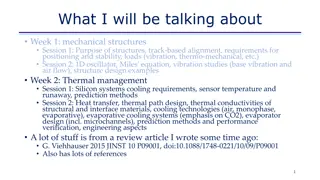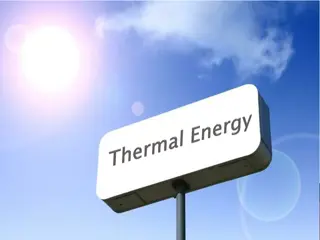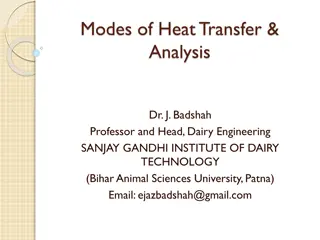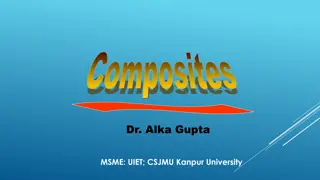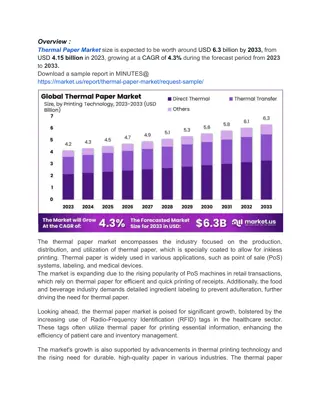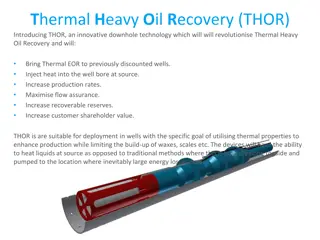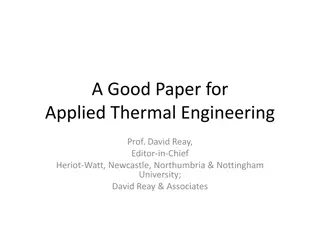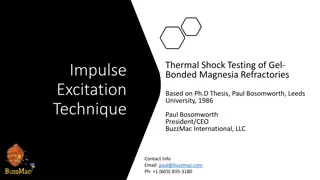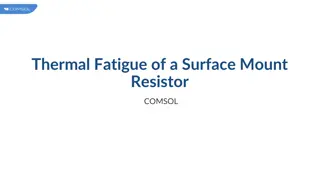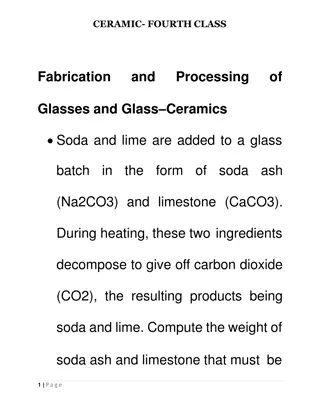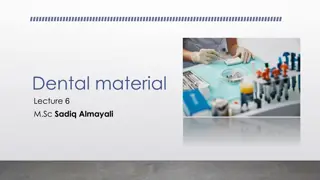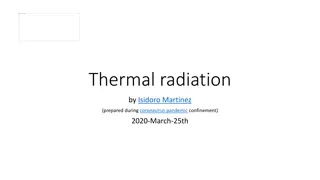Understanding Thermal Properties of Materials
Materials respond differently to heat based on their thermal properties such as heat capacity, thermal expansion, conductivity, and shock resistance. The ability of materials to absorb heat, expand with temperature changes, and conduct heat varies across ceramics, metals, and polymers. Heat capacity, dependent on temperature, is higher for polymers compared to metals and ceramics. Thermal expansion causes changes in size with temperature, influenced by the materials' atomic vibrations. Understanding these thermal properties is crucial in material analysis and application.
Download Presentation

Please find below an Image/Link to download the presentation.
The content on the website is provided AS IS for your information and personal use only. It may not be sold, licensed, or shared on other websites without obtaining consent from the author. Download presentation by click this link. If you encounter any issues during the download, it is possible that the publisher has removed the file from their server.
E N D
Presentation Transcript
Chapter 19: Thermal Properties ISSUES TO ADDRESS... How do materials respond to the application of heat? How do we define and measure... -- heat capacity? -- thermal expansion? -- thermal conductivity? -- thermal shock resistance? How do the thermal properties of ceramics, metals, and polymers differ? Chapter 19 - 1
Heat Capacity The ability of a material to absorb heat Quantitatively: The energy required to produce a unit rise in temperature for one mole of a material. energy input (J/mol) dQ heat capacity (J/mol-K) C = dT temperature change (K) Two ways to measure heat capacity: Cp : Heat capacity at constant pressure. Cv : Heat capacity at constant volume. Cpusually > Cv J Btu Heat capacity has units of mol K lb mol F Chapter 19 - 2
Dependence of Heat Capacity on Temperature Heat capacity... -- increases with temperature -- for solids it reaches a limiting value of 3R Cv= constant R = gas constant 3R = 8.31 J/mol-K Adapted from Fig. 19.2, Callister & Rethwisch 8e. 0 T (K) D 0 Debye temperature (usually less than Troom) From atomic perspective: -- Energy is stored as atomic vibrations. -- As temperatureincreases, the average energy of atomic vibrations increases. Chapter 19 - 3
Atomic Vibrations Atomic vibrations are in the form of lattice waves or phonons Adapted from Fig. 19.1, Callister & Rethwisch 8e. Chapter 19 - 4
Specific Heat: Comparison cp (J/kg-K) at room T 1925 1850 1170 1050 Material Polymers Polypropylene Polyethylene Polystyrene Teflon cp(specific heat): (J/kg-K) Cp(heat capacity): (J/mol-K) Why is cpsignificantly larger for polymers? increasing cp Ceramics Magnesia (MgO) Alumina (Al2O3) Glass 940 775 840 Metals Aluminum Steel Tungsten Gold 900 486 138 128 Selected values from Table 19.1, Callister & Rethwisch 8e. Chapter 19 - 5
Thermal Expansion Materials change size when temperature is changed Tinitial initial Tfinal> Tinitial Tfinal final lfinal linitial linitial linear coefficient of thermal expansion (1/K or 1/ C) = l(Tfinal Tinitial) Chapter 19 - 6
Atomic Perspective: Thermal Expansion Asymmetric curve: -- increase temperature, -- increase in interatomic separation -- thermal expansion Symmetric curve: -- increase temperature, -- no increase in interatomic separation -- no thermal expansion Chapter 19 - 7 Adapted from Fig. 19.3, Callister & Rethwisch 8e.
Coefficient of Thermal Expansion: Comparison (10-6/ C) at room T Material Polymers Polymers have larger values because of weak secondary bonds Polypropylene Polyethylene Polystyrene Teflon Metals Aluminum Steel Tungsten Gold 145-180 106-198 90-150 126-216 Q: Why does generally decrease with increasing bond energy? increasing 23.6 12 4.5 14.2 Ceramics Magnesia (MgO) Alumina (Al2O3) Soda-lime glass Silica (cryst. SiO2) 13.5 7.6 9 0.4 Selected values from Table 19.1, Callister & Rethwisch 8e. Chapter 19 - 8
Thermal Expansion: Example Ex: A copper wire 15 m long is cooled from 40 to -9 C. How much change in length will it experience? =16.5 x10 6( C) 1 Answer: For Cu rearranging Equation 19.3b = [ = 6 T 16 5 . x 10 / 1 ( C )]( 15 m [ ) 40 C ( 9 C )] 0 . 0 = = 012 m 12 mm Chapter 19 - 9
Thermal Conductivity The ability of a material to transport heat. Fourier s Law temperature gradient dT = q k dx heat flux (J/m2-s) thermal conductivity (J/m-K-s) T2 T1 T2> T1 x1 x2 heat flux Atomic perspective: Atomic vibrations and free electrons in hotter regions transport energy to cooler regions. Chapter 19 -10
Thermal Conductivity: Comparison Energy Transfer Mechanism Material k (W/m-K) Metals Aluminum Steel Tungsten Gold 247 52 178 315 atomic vibrations and motion of free electrons Ceramics Magnesia (MgO) Alumina (Al2O3) Soda-lime glass Silica (cryst. SiO2) increasing k 38 39 1.7 1.4 atomic vibrations Polymers Polypropylene Polyethylene Polystyrene Teflon Selected values from Table 19.1, Callister & Rethwisch 8e. 0.12 0.46-0.50 0.13 0.25 vibration/rotation of chain molecules Chapter 19 -11
Thermal Stresses Occur due to: -- restrained thermal expansion/contraction -- temperature gradients that lead to differential dimensional changes Thermal stress= = E (T0 Tf) = E T Chapter 19 -12
Example Problem -- A brass rod is stress-free at room temperature (20 C). -- It is heated up, but prevented from lengthening. -- At what temperature does the stress reach -172 MPa? Solution: T0 Original conditions 0 Step 1: Assume unconstrained thermal expansion 0 = thermal= (Tf T0) Tf room Step 2: Compress specimen back to original length 0 compress= = thermal room Chapter 19 - 13
Example Problem (cont.) 0 The thermal stress can be directly calculated as = E( compress) Noting that compress = - thermal and substituting gives = E( thermal) = E (Tf T0) = E (T0 Tf) Rearranging and solving for Tf gives 20 C -172 MPa (since in compression) Tf=T0 E Answer: 106 C 20 x 10-6/ C 100 GPa Chapter 19 -14
Thermal Shock Resistance Occurs due to: nonuniform heating/cooling Ex: Assume top thin layer is rapidly cooled from T1 to T2 rapid quench T2 T1 Tension develops at surface = E (T1 T2) Critical temperature difference for fracture (set = f) (T1 T2)fracture= tries to contract during cooling resists contraction Temperature difference that can be produced by cooling: quench ) ( 2 1 = f rate T T E k set equal (quench rate)for fracture= Thermal Shock Resistance ( TSR) fk E fk E Large TSR when is large Chapter 19 -15
Thermal Protection System Re-entry T Distribution Application: Space Shuttle Orbiter reinf C-C (1650 C) silica tiles (400-1260 C) nylon felt, silicon rubber coating (400 C) Chapter-opening photograph, Chapter 23, Callister 5e (courtesy of the National Aeronautics and Space Administration.) Fig. 19.2W, Callister 6e. (Fig. 19.2W adapted from L.J. Korb, C.A. Morant, R.M. Calland, and C.S. Thatcher, "The Shuttle Orbiter Thermal Protection System", Ceramic Bulletin, No. 11, Nov. 1981, p. 1189.) Silica tiles (400-1260 C): -- large scale application -- microstructure: ~90% porosity! Si fibers bonded to one another during heat treatment. 100 m Fig. 19.3W, Callister 5e. (Fig. 19.3W courtesy the National Aeronautics and Space Administration.) Fig. 19.4W, Callister 5e. (Fig. 219.4W courtesy Lockheed Aerospace Ceramics Systems, Sunnyvale, CA.) Chapter 19 -16
THERMAL DIFFUSIVITY It measures the ability of a material to conduct thermal energy relative to its ability to store thermal energy.It has the SI unit of m /s. Thermal diffusivity is usually denoted by The formula is: = k/(c x rho ) where k is thermal conductivity (W/(m K)) rho is density (kg/m ) c is specific heat capacity (J/(kg K)) Chapter 19 -17
Summary The thermal properties of materials include: Heat capacity: -- energy required to increase a mole of material by a unit T -- energy is stored as atomic vibrations Coefficient of thermal expansion: -- the size of a material changes with a change in temperature -- polymers have the largest values Thermal conductivity: -- the ability of a material to transport heat -- metals have the largest values Thermal shock resistance: -- the ability of a material to be rapidly cooled and not fracture fk E -- is proportional to Chapter 19 -18
ANNOUNCEMENTS Reading: Core Problems: Self-help Problems: Chapter 19 -19




